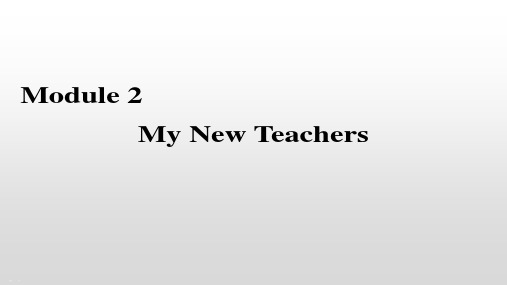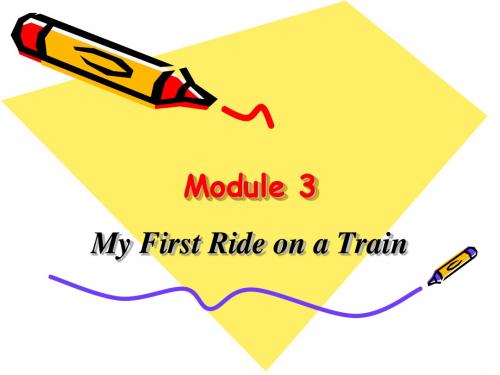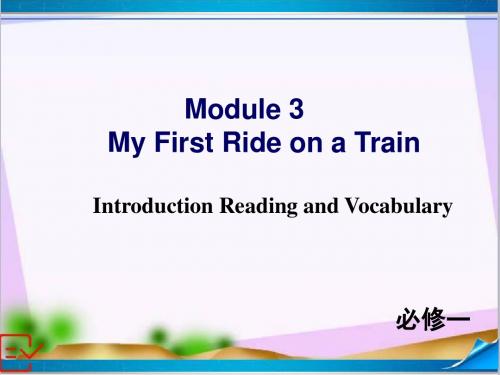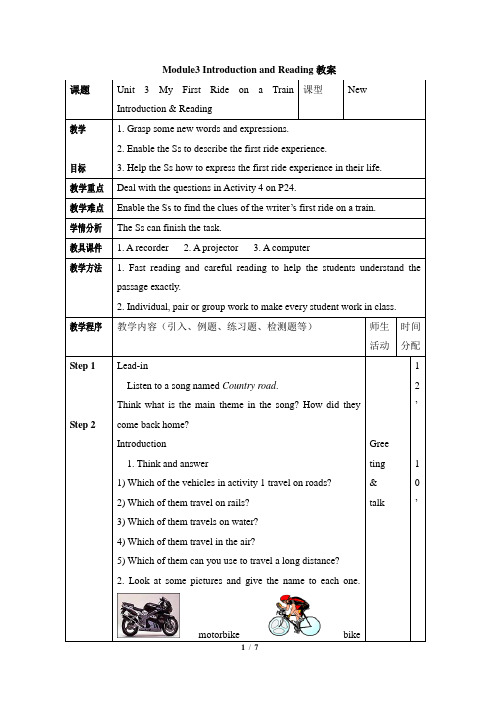3外研版必修一 module3 introduction
- 格式:ppt
- 大小:1.07 MB
- 文档页数:20





Module3 单元教材分析一、教学内容分析本模块是必修1的第3模块,话题是my first ride on a train,本模块是通过旅游经历介绍风光,帮助学生学会关于交通工具和地貌等自然现象的词语,学会运用表示过去的用语作回忆、写游记、介绍风光。
本模块分为几下几个部分,各部分的内容和任务如下:Introduction是导入部分,内容包括:学习有关交通工具的名词和动词,回忆第一次旅游的快乐情景,通过查找信息,描述自己印象中的澳大利亚,学习部分有关Reading中将要出现的生词(需要在文章中猜测的词汇除外)。
Reading and vocabulary学习在澳大利亚乘火车旅游的文章,训练速读、略读和查读技能,通过中心句掌握全文中心,学会分析文章结构,学会运用想象、联想、逻辑分析和英语思维的能力,学会如何描述乘火车旅游的情形。
Grammar部分是语法的讲解,学会通过合作探究,归纳总结出-ed形容词作定语及其定语的位置,运用过去时间表达法。
Function情景交际,训练根据对方话语作出回应、表达态度的技能。
Vocabulary, reading and speaking学习表示地点和在该地点做事的词汇,训练联想的认知策略,学习有关回忆的文章,能叙述自己的回忆。
Writing:借助一切可借助的力量介绍自己的一次旅游情况,写童年某一事件的过程,训练记忆、整理和归纳等逻辑思维能力。
Pronunciation学习句子重音发音规律和规则。
Everyday English训练根据对方话语作出回应、表达态度的技能。
Cultural Corner与模块主题相关的、关于文化的阅读文段,进一步发展用英语获取(文化)信息的能力,拓展思维,享受阅读的乐趣。
了解Maglev,能说出与普通火车的区别。
Task提供相对真实语境和任务,使学生综合本单元所学技能和知识有效完成任务。
有些开发型任务有利于高中学生运用语言获取信息,进行思维,相互合作,展示个性,使语言学习的学以致用的原则得到体现。

Module1 EuropeⅠ. 教学内容分析本模块以Europe为话题,介绍了几座著名的欧洲城市。
通过模块教学,学生要学会运用所学词汇描述自己所了解的城市,介绍城市的所在位置;教师要引导学生正确认识和看待欧洲经济的发展,激发学生努力学习、建设祖国的雄心壮志。
Introduction 部分通过填充欧洲地图,使学生对欧洲一些国家的国名、首都及地理位置做一个初步了解,引发学生进一步探究的兴趣。
Reading and vocabulary部分通过阅读对Paris, Barcelona, Florence,和Athens 四座欧洲名城的介绍,让学生学会相关词汇,并了解如何写城市介绍。
Function部分通过对一些表方位的介词短语的介绍,让学生学会说明一个地点的确切方位。
Grammar 1 部分通过观察课文中的例句,要求学生了解被动语态的使用。
Listening 部分通过听取一段三人间的对话对Cardiff, Valencia和Edinburg进行了介绍,让学生获取信息,完成相关练习,进一步了解欧洲名城。
Writing 部分通过让学生进一步获取信息来加深对欧洲城市的了解,并根据所获取的信息加写介绍欧洲城市人文环境的段落,使课文信息更加丰富。
Grammar 2 部分列举了以集合名词作主语的句子,让学生考虑主谓搭配,并通过练习加以巩固。
Pronunciation and Everyday English 部分通过听力练习,让学生掌握反义疑问句的语调变化,了解升调和降调的使用规律。
Cultural Corner部分是对欧盟的介绍,让学生了解欧盟有哪些成员国及欧盟的发展史。
Task部分是对本模块所学内容的一个复习和应用,要求学生小组活动,查找资料,利用本模块词汇设计一个资料包,介绍中国一个地区或城市。
Module File部分有助于学生对本模块内容进行归纳,对自己的学习进行总结和检验。
Ⅱ. 教学重点和难点教学重点掌握与城市发展相关的词汇;学习主谓一致及被动语态的语法功能;学习运用不同的介词表达不同的位置。
《Body Language and Non-verbal Communication》教学课例黑龙江省大庆市第五十六中学荆棘一、教学内容分析本节课为外研版高一英语必修4 Module 3 的Introduction部分。
该部分含有四个活动,引入了与各种身体动作或姿态有关的词汇,以及在交际场合人们所用的部分词汇和可能采用的身势语。
通过这些活动,学生可以初步熟悉有关非言语交际的词汇,为接下来的阅读学习活动做好准备。
二、教学目标(1)初步学习有关非言语交际的词汇:shake, point , wave, clap one’s hand….(2)学习描述非言语交际的语言,增加语言输入量,提高学生的语言表达能力。
(3 了解中外有关非言语交际的文化习俗,增强交际意识。
(4)通过小组活动培养学生的自主学习能力,合作学习能力和探究精神。
三、教学重点与难点熟练掌握描述非言语交际的语言。
四、教学用具录音机及多媒体。
五、教学过程Step 1 Topic Presentation1. Lead in(1) After greeting, ask the students to stand up and sit down once again by showing them gestures.(2) Ask one student to the blackboard to clean the blackboard by gesture.(3) Then present the topic: Body Language and Non-verbal Communication:Body language is often used by people for sending messages to the people around us. It is very useful because it can help us make ourselves understood. That is, we often use our body expressions and movements. e.g. A smile and handshake show welcome. Waving one’s hands is to say “Goodbye”. Nodding the head means agreement , while shaking it means disagreement.2. Practice(1) Show the students a few pictures about gestures on the screen, then ask and answer questions.(2) Ask the students to give more examples about body language.Step 2 Topic Description1. Get the students to look at the pictures in the textbooks, then1) ask and answer questions.2) match the pictures with the words shake ,point, wave and shake .3) Ask the students to look at the pictures in the textbooks and describe what the people are doing, using these words: point wave smile shake.(1)The two youths are talking. The boy is _________ the way.(2)The lady is ____ her hand, she is likely to say “goodbye”to somebody.(3)The white man is ____, maybe he is welcoming the black man.(4)The two middle-aged men are ___ hands, perhaps they are greeting.2. Listen to the tape and match the pictures.Step 3 Topic Discussion1.Get the students to discuss “what do you do when …..?” and then actthem out .(1)meet a friend(2)show someone the way(3)see a friend in the distance(4)enter a friend’s house(5)say yes(6)say no(7)say who? Me?(8) say good bye1)I smile and say “How are you doing?”2)I point the way and say, “Go this way, please.”3)I wave my hand and say “Hello. ”4)I smile and say: “Glad to visit your house.”5)I nod my head up and down.6)I shake my head from side to side.7)I open my eyes wide pointing at myself with my index finger.8)I wave my hands and say: “Goodbye.”2. Discuss about two more pictures (or situations ):When do we use themand what do we say ?Discussion : Look at the pictures and discuss when we use them &what we say.Step 4 Topic Practice1.Ask the students to make gestures and guess what they mean:1. Raise your hand.2. Put up your hands.3. Wave your hands.4. Cup your ear.5. Kiss your hand to someone.6. Thumbs up.7. Thumbs down.1)Raise your hand .To ask or answer a question./ To attract attention .2)Put up your hands.To give up ./ To surrender.3)Wave your hands.To say goodbye.4)Cup your ear.To say ,“I beg your pardon.”/ “Sorry, I can’t hear you”.5)Kiss your hand to someone.To say “Goodbye” to a dear friend or relative.6)Thumbs up.To say“ Great!/Wonderful!/Well done!/Congratulation!”7)Thumbs down.To say “No good!/ Terrible!”2. Listen to the song “I f Your Are Happy ”then ask the students to pick out the sentences about body language.If You Are HappyIf you're happy and you know it clap Your handsIf you're happy and you know itNever be afraid to show itIf you're happy and you know it clap your handsIf you're happy and you know it stomp your feetIf you're happy and you know itNever be afraid to show itIf you're happy and you know it stomp your feetIf you're happy and you know it wink your eyesIf you're happy and you know itNever be afraid to show itIf you're happy and you know it wink your eyesStep 5 Topic ConclusionBody Language &Non-verb CommunicationWe use movements or positions of our body to show other people what we are thinking or feeling.But not all the body language means the same thing in different countriesStep 6 HomeworkWhen and where do people use more body language than spoken language ? e.g. Direct the trafficJudges of sportsAsk for help in the distan ce…。